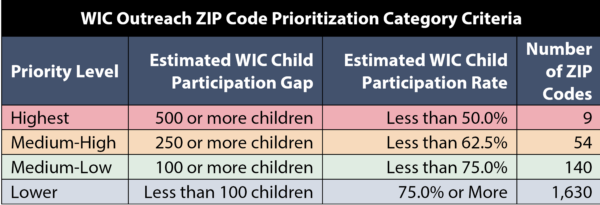By Zach Zook, VP/Director of Impact and Policy
The Special Supplemental Nutrition Program for Women, Infants, and Children, or WIC, is the third largest federal nutrition program in the United States; however, utilization of the program consistently trails eligibility. WIC provides crucial nutritional support to pregnant individuals and households with children under the age of five by giving participants EBT cards to purchase approved highly nutritious foods. WIC is an important, effectively targeted program as nutrition gaps during pregnancy and early childhood are associated with long-term negative outcomes. Additionally, national studies show that households with children are more likely than any other household type to face food insecurity.
Central Pennsylvania Food Bank Community Hunger Mapping projects, including the recently released Dauphin County report, also show that WIC utilization rates for likely-eligible households trail eligibility significantly. Just one-third of likely-eligible pantry visitor households participate in WIC in Dauphin County. However, WIC reduces very low food security significantly among participants, as shown in the graph to the right. WIC participants have a very low food security rate of 39% compared to likely eligible households of the same income level who do not participate.
Compared to the rest of the country, Pennsylvania is tied for the tenth lowest utilization rate among all states, so there is substantial room to increase participation across the Commonwealth as well as in the CFPB’s service territory. To contribute to WIC outreach efforts and enable them to effectively target smaller geographies, this policy blog estimates which ZIP Codes have the highest WIC utilization gaps in Pennsylvania as of December 2024.

To calculate WIC utilization gaps and prioritize ZIP Codes accordingly, CPFB researchers created a novel prioritization technique using participation data from the Pennsylvania Department of Health and estimated eligibility data from the 2019-2023 American Community Survey. The prioritization method includes participation rates and the magnitude of the participation gap as both measures contribute to the potential effectiveness and return on investment from targeted WIC program outreach.
This method classifies ZIP Codes into four categories based on the criteria listed in the table shown at right: Highest priority, Medium-High priority, Medium-Low priority, and Lower priority. Across the state, nine ZIP Codes are classified as Highest priority, 54 are classified as Medium-High priority, and 140 are classified as Medium-Low Priority. Altogether, these 203 target ZIP Codes make up 11% of the 1,830 ZIP Codes in Pennsylvania.

The benefit of this classification methodology is that it maximizes the efficacy of geographic WIC outreach. Focusing on areas with a large child participation gap and low participation rates allows stakeholders to conduct outreach focused on a relatively small number of geographies but still reach a large proportion of likely eligible children. In fact, the 203 Priority ZIP Codes for WIC Outreach contain just 44% of children under the age of five, but 80% of likely-eligible but non-participating children.

The results of this analysis and the corresponding priority ZIP codes are shown in the interactive dashboard map previewed below, which can also be found at this link. This map highlights each priority ZIP as well as showing the size of the participation gap for ZIP Codes with estimated gaps of more than 100 children.
